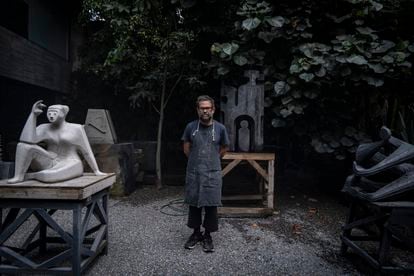Pedro Reyes, the sculptor of the work Tlali that will be exhibited in Paseo de la Reforma in Mexico City, replacing the statue of Columbus, in an interview for EL PAÍS.Nayeli Cruz
The
Tlali
sculpture
, by Pedro Reyes, has not yet reached the Paseo de la Reforma and its demolition has already been requested. A letter signed by 350 people from the world of culture demands that the head of government of Mexico City, Claudia Sheinbaum, remove Reyes from the project. Headed by artists such as Laureana Toledo and Mónica Mayer, the letter demands that a committee made up of women from indigenous communities be installed to elect a sculptor, also belonging to one of the indigenous peoples, to replace him.
The signatories, among whom are the writers Gabriela Jáuregui and Eduardo Abaroa, the art historians Graciela de la Torre and Sol Henaro or the artists Lorena Wolffer and Julieta Aranda, according to
El Universal
, have a clear premise: the sculpture in homage to indigenous women must be carried out by one of them.
“The choice of Pedro Reyes, a male artist who does not self-identify as indigenous, to represent 'the indigenous woman' is inadmissible: thus, generalized, thereby denying the particularity and diversity of women who self-identify as members of peoples and original nations, and putting their image in the hands of the gaze of a white-mestizo man, "says the text.
More information
Opinion |
'Monumental controversies', by Antonio Ortuño
The announcement in early September of the removal of the statue of Christopher Columbus from one of the main avenues of the capital was only the beginning of the controversy. The sculpture of the Genoese admiral was removed from its gazebo in October 2020 on the pretext that it was to be restored, however, the Sheinbaum Government has finally chosen to move it to another park in the city. In its place in Reforma, the Executive has decided to erect a monument in homage to indigenous women.
The commission was awarded —without a public tender— to the Mexican artist Pedro Reyes. The sculptor presented his proposal a few days ago:
Tlali
, which comes from the Nahualt word tlalli —which means earth— and inspired by the colossal Olmec heads. Since then, criticism and questions have arisen: how is an indigenous woman represented? Was Reyes the right person for the project?
In an interview with EL PAÍS, the artist maintained that he had been selected due to the background of his work and the urgency of the commission. “In the last 15 or 20 years I have felt very lonely, I have been working stone carving and nobody else does it. It is not so much a question of gender but a question of who has been working in these types of formats ”, pointed out Reyes, who considered that civic or monumental sculpture has been a format abandoned by most of the artists of his generation.
"So regardless of gender, I think there are not many people who have been working in that direction and who can respond to the times that the assignment requires," he explained. Just two months ago, the capital government proposed to the artist to take charge of the monument. The deadline was short: it had to be ready, at most, in early 2022. Reyes also valued the team of 40 sculptors with whom he works in three workshops in order to have been chosen. "They are working in Iztapalapa, Chimalhuacán and Coyoacán, which are also indigenous peoples, where there is a great tradition of direct stone carving."
However, the promoters of the letter sent to the head of government demand that women from indigenous communities should be in charge of the production and manufacture of the new monument.
For the artists, the election of Reyes “reproduces the silencing and invisibility of the struggle of women and their native peoples so that their voice is recognized and heard, and to define their own stories, without being subject to tutelage and expectations. and the narratives of those who have exercised power over them ”.
Subscribe here
to the
newsletter
of EL PAÍS México and receive all the informative keys of the current situation of this country

